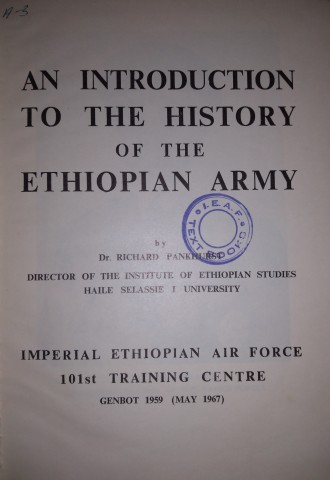Richard Pankhurst made innumerable contributions to the history of Ethiopia. I found an original copy of "An Introduction fo the History of the Ethiopian Army", published by the Imperial Ethiopian Air Force, 101st Training Centre, in 1967. The Forward (of only 2 pages) by Colonel Aberra Wolde Mariam provide interesting insight into the thinking of the Ethiopian Military of the time, such as his comment that "no amount of technical skill and professional competence will win a war or achieve any worthwhile purpose unless it is coupled with that genuine pride and strong faith which alone is the driving force capable of stirring on to action despite insurmountable difficulties."
The book is 183 pages. A small portion (p. 3-17) covers the ancient and medieval times, followed be larger chapters on the army in the nineteenth and early twentieth centuries (p. 18-60) and the history of firearms (p. 61-147). A concluding chapter speaks about the effects of war (p. 148-183). The book contains a large number of endnotes for each chapter, which Pankhurst says are largely for the benefit of students and historians who want to pursue the matters discussed in greater detail. As Pankhurst books are known for, the book is detailed and offers an immense about of detail otherwise extremely difficult to locate.
A few notes from the text:
- "Traditionally the soldiers did not constitute a separate section of the population, but were ordinary citizens mobilized by their rulers in time of need. Alvares, describing the set-up in the sixteenth century, noted that many lords, courtiers and even minor functionaries, such as trumpeteers, received grants of land in return for their service, while Almeida declared: "So that they should follow soldiering and continue to do so the Emperor grants them the lands on which they live and and which they enjoy in as much as they serve him. As soon as they fail him he gives the land to others"." (p. 7)
- "The institution of war, as we have seen, played an important role in the economic and social life of Ethiopia in traditional times. Fighting against internal or external enemies was a frequent occurrence and involved very large armies, often composed of fifty or a hundred thousand men with numerous camp followers. The fact that the soldiers were unpaid meant that they were obliged to requisition or loot whatever they required from the countries through which they passed, irrespective of whether the inhabitants were friends or foes." (p. 148)
- "The result, Pearce says, was that "the people... never know when their persons or property are safe, on which account they are obliged to repair to the habitations of their chief on holydays, some presenting bread, butter, honey, and corn, and others a goat, sheep, or fowls, to keep in favour, and to prevent him from sending his soldiers to live upon their premises." Though legal redress was often outside their power, perhaps for that very reason, the peasants showed great ingenuity in protecting themselves from the soldiers' rapacity. Peasantry and soldiery were in fact often engaged in a ceaseless battle of wits. "It is custom," Pearce relates, "for the inhabitants of the villages to have gudgauds, large pits under-ground, plastered within with cowdung and mud, and having the mouth very narrow, some of which are made to hold forty or fifty churns or corn, between three and four hundred English bushels." (p. 149)
- Wylde explained that they [soldiers] seemed to increase their demands in areas of better cultivation, particularly where irrigation was practised: "Very often," he says, "the soldiers when they are on the march and cannot procure supplies from the natives, break down the slight banks of the channels, and in a few minutes destroy the labour of perhaps many days. Knowing what will happen if they do not give supplies, the peasants are most easily imposed upon, and the soldiers, when going through a country that depends upon irrigation for summer crops, always demand more from the people than in other places"." (p. 170)

